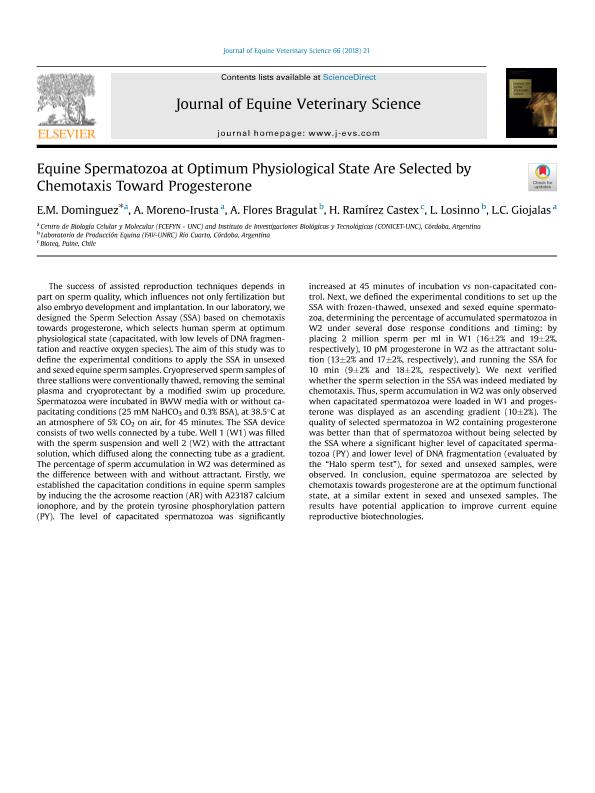Mostrar el registro sencillo del ítem
dc.contributor.author
Dominguez, Esteban Mauricio

dc.contributor.author
Moreno, Ayelen

dc.contributor.author
Flores Bragulat, Ana Paula

dc.contributor.author
Ramírez Castex, Hernan
dc.contributor.author
Losinno, Luis

dc.contributor.author
Giojalas, Laura Cecilia

dc.date.available
2019-11-11T13:37:20Z
dc.date.issued
2018-07
dc.identifier.citation
Dominguez, Esteban Mauricio; Moreno, Ayelen; Flores Bragulat, Ana Paula; Ramírez Castex, Hernan; Losinno, Luis; et al.; Equine spermatozoa at optimum physiological state are selected by chemotaxis toward progesterone; Elsevier Science Inc; Journal of Equine Veterinary Science; 66; 7-2018; 21
dc.identifier.issn
0737-0806
dc.identifier.uri
http://hdl.handle.net/11336/88419
dc.description.abstract
The success of assisted reproduction techniques depends inpart on sperm quality, which influences not only fertilization butalso embryo development and implantation. In our laboratory, wedesigned the Sperm Selection Assay (SSA) based on chemotaxistowards progesterone, which selects human sperm at optimumphysiological state (capacitated, with low levels of DNA fragmentation and reactive oxygen species). The aim of this study was todefine the experimental conditions to apply the SSA in unsexedand sexed equine sperm samples. Cryopreserved sperm samples ofthree stallions were conventionally thawed, removing the seminalplasma and cryoprotectant by a modified swim up procedure.Spermatozoa were incubated in BWW media with or without capacitating conditions (25 mM NaHCO3 and 0.3% BSA), at 38.5C atan atmosphere of 5% CO2 on air, for 45 minutes. The SSA deviceconsists of two wells connected by a tube. Well 1 (W1) was filledwith the sperm suspension and well 2 (W2) with the attractantsolution, which diffused along the connecting tube as a gradient.The percentage of sperm accumulation in W2 was determined asthe difference between with and without attractant. Firstly, weestablished the capacitation conditions in equine sperm samplesby inducing the the acrosome reaction (AR) with A23187 calciumionophore, and by the protein tyrosine phosphorylation pattern(PY). The level of capacitated spermatozoa was significantlyincreased at 45 minutes of incubation vs non-capacitated control. Next, we defined the experimental conditions to set up theSSA with frozen-thawed, unsexed and sexed equine spermatozoa, determining the percentage of accumulated spermatozoa inW2 under several dose response conditions and timing: byplacing 2 million sperm per ml in W1 (162% and 192%,respectively), 10 pM progesterone in W2 as the attractant solution (132% and 172%, respectively), and running the SSA for10 min (92% and 182%, respectively). We next verifiedwhether the sperm selection in the SSA was indeed mediated bychemotaxis. Thus, sperm accumulation in W2 was only observedwhen capacitated spermatozoa were loaded in W1 and progesterone was displayed as an ascending gradient (102%). Thequality of selected spermatozoa in W2 containing progesteronewas better than that of spermatozoa without being selected bythe SSA where a significant higher level of capacitated spermatozoa (PY) and lower level of DNA fragmentation (evaluated bythe ?Halo sperm test?), for sexed and unsexed samples, wereobserved. In conclusion, equine spermatozoa are selected bychemotaxis towards progesterone are at the optimum functionalstate, at a similar extent in sexed and unsexed samples. Theresults have potential application to improve current equinereproductive biotechnologies
dc.format
application/pdf
dc.language.iso
eng
dc.publisher
Elsevier Science Inc

dc.rights
info:eu-repo/semantics/openAccess
dc.rights.uri
https://creativecommons.org/licenses/by-nc-sa/2.5/ar/
dc.subject
SPERMATOZOA
dc.subject
CHEMOTAXIS
dc.subject
PROGESTERONE
dc.subject.classification
Otras Ciencias Veterinarias

dc.subject.classification
Ciencias Veterinarias

dc.subject.classification
CIENCIAS AGRÍCOLAS

dc.title
Equine spermatozoa at optimum physiological state are selected by chemotaxis toward progesterone
dc.type
info:eu-repo/semantics/article
dc.type
info:ar-repo/semantics/artículo
dc.type
info:eu-repo/semantics/publishedVersion
dc.date.updated
2019-10-22T17:34:35Z
dc.journal.volume
66
dc.journal.pagination
21
dc.journal.pais
Países Bajos

dc.journal.ciudad
Amsterdam
dc.description.fil
Fil: Dominguez, Esteban Mauricio. Consejo Nacional de Investigaciones Científicas y Técnicas. Centro Científico Tecnológico Conicet - Córdoba. Instituto de Investigaciones Biológicas y Tecnológicas. Universidad Nacional de Córdoba. Facultad de Ciencias Exactas, Físicas y Naturales. Instituto de Investigaciones Biológicas y Tecnológicas; Argentina. Universidad Nacional de Córdoba. Facultad de Ciencias Exactas, Físicas y Naturales. Centro de Biología Celular y Molecular; Argentina
dc.description.fil
Fil: Moreno, Ayelen. Consejo Nacional de Investigaciones Científicas y Técnicas. Centro Científico Tecnológico Conicet - Córdoba. Instituto de Investigaciones Biológicas y Tecnológicas. Universidad Nacional de Córdoba. Facultad de Ciencias Exactas, Físicas y Naturales. Instituto de Investigaciones Biológicas y Tecnológicas; Argentina. Universidad Nacional de Córdoba. Facultad de Ciencias Exactas, Físicas y Naturales. Centro de Biología Celular y Molecular; Argentina
dc.description.fil
Fil: Flores Bragulat, Ana Paula. Universidad Nacional de Rio Cuarto. Facultad de Agronomia y Veterinaria. Departamento de Producción Animal. Laboratorio de Reproducción Equina; Argentina. Consejo Nacional de Investigaciones Científicas y Técnicas; Argentina
dc.description.fil
Fil: Ramírez Castex, Hernan. Centro de Reproducción Equina Bioteq; Chile
dc.description.fil
Fil: Losinno, Luis. Universidad Nacional de Rio Cuarto. Facultad de Agronomia y Veterinaria. Departamento de Producción Animal. Laboratorio de Reproducción Equina; Argentina
dc.description.fil
Fil: Giojalas, Laura Cecilia. Consejo Nacional de Investigaciones Científicas y Técnicas. Centro Científico Tecnológico Conicet - Córdoba. Instituto de Investigaciones Biológicas y Tecnológicas. Universidad Nacional de Córdoba. Facultad de Ciencias Exactas, Físicas y Naturales. Instituto de Investigaciones Biológicas y Tecnológicas; Argentina. Universidad Nacional de Córdoba. Facultad de Ciencias Exactas, Físicas y Naturales. Centro de Biología Celular y Molecular; Argentina
dc.journal.title
Journal of Equine Veterinary Science

dc.relation.alternativeid
info:eu-repo/semantics/altIdentifier/url/https://www.sciencedirect.com/science/article/pii/S0737080618302077
dc.relation.alternativeid
info:eu-repo/semantics/altIdentifier/doi/http://dx.doi.org/10.1016/j.jevs.2018.05.003
Archivos asociados
